Environmental
IUMO - Crossrail 2
A
and Economic Impact of New Technology
Rethinking the future of mobility with IUMO – the on-demand, personalised, sustainable, mass transit option.
1 What is IUMO?
2 Why is IUMO a better alternative to Crossrail 2?
3 IUMO & Crossrail 2 key points
4 The IUMO experience
5 Looking forward
What is IUMO? 1
1
What is IUMO?
IUMO (Integrated Urban MObility) reimagines mass transit, by replacing conventional trains with highspeed platoons of shared Autonomous Electric Vehicles (AEVs) running in both directions in a single Crossrail tunnel.
IUMO features demand-responsive AEVs operating within a segregated track transport system.
The on-demand service, controlled by an app, takes travelers directly to their destination station without stopping in between.
The AEVs are controlled via a dynamic platoon system, allowing them to move within milliseconds of each other. This way cars travel together in a continuous flow at a steady speed without ever slowing down.
IUMO could support existing transport systems and radically change how we move around cities. With no more cross modal waiting, no more sardining in the underground and no more timetables, IUMO is the next best thing to teleportation.
3
PLP Labs
tunnel & AEV dimensions 7.8m 7.9m 2m 2m 2.5m 2.5m 3.31m 3m 0.3m 0.3m
IUMO
Moving to public shared transport
Just as the car shaped urban life in the 20th Century, new transport technology will determine how we create and navigate urban developments in the 21st Century.
Large infrastructure projects historically encounter serious political and economic obstacles. Crossrail 2, the UK government’s extension of the capital’s new rail system is no exception. Given changing economic conditions from the onset of the pandemic, the second phase of the project is officially on hold until further notice. However, the suspension of Crossrail 2 development provides a unique window to evaluate radical alternatives to conventional train solutions.
IUMO reimagines public transport. Through the integration of new technology, passengers can be grouped by desired endstation and directed to specific public transit vehicles. The system prioritises constant traffic flow, in which vehicles only stop at the user’s intended destinations.
IUMO reinvents how space within traditional underground tunnels is used. Instead of relying on one-way travel, twoway vehicle lanes are stacked on top of each other within one tunnel. The optimisation of space, along with other measures, can ultimately halve the capital cost of the project. This type of approach to public transport is ultimately more convenient, affordable, and sustainable.
5
What is IUMO?
PLP Labs
What is this project in particular?
This report demonstrates that a shared vehicle system is a viable alternative to conventional rail. AEVs, within a IUMO network, can double the average speed and passenger density of a Crossrail system whilst providing a far more efficient and comfortable mode of travel for all passengers.
This new approach has the potential to withstand the transport needs of the future and pave the path towards more sustainable and adaptable cities.
Rather than looking at the vehicular technology itself, this report offers network protocols that revolve around fundamentals of convenience, affordability, and sustainability.
IUMO is a long-running research project by PLP Labs, the research and innovation arm of PLP Architecture. The IUMOCrossrail 2 study is part of a partnership with Dr. Panagiotis Angeloudis from the Transport Systems+Logistics Laboratory and Reed Mobility, supported by the Epic Games MegaGrant.
7
What is IUMO?
Why is IUMO a better alternative to Crossrail 2?
Rethinking the future of mobility with IUMO – the on-demand, personalised, sustainable, mass transit option.
9
2
IUMO is a form of shared-vehicle public transport with the convenience of the car — the ultimate on-demand system — and the efficiency of mass-transport. The six-seater AEVs operate through an AI booking system for optimal deployment and sharing of vehicles. The AEV booking system is adaptable, aiming for maximum capacity at rush hour while keeping occupancy options open at other times to cater for personal preferences.
This system runs on an on-demand basis, in which vehicles will only stop at the intended destination without interruptions. As a result, average speed of IUMO is double that of a train system in which every train stops at every station.
The AEVs will also adopt a ‘conveyor belt’ approach to spacing ensuring there are never any queues or hold-ups. Ultimately, IUMO’s efficiency stems from its nimble, intuitive, and personalised system on a mass-transit scale.
11
Why
is IUMO a good alternative to Crossrail 2? More convenient
More affordable
IUMO’s infrastructure and operational costs are less expensive than a traditional train system. First, IUMO transports more vehicles, and by extension more people, within standard underground tunnels. Four small standardised AEVs, two in either direction, can fit into a single-lane Crossrail 2 tunnel. Tunnel costs are halved due to the compact nature of the IUMO system that requires one tunnel, instead of two. Platform sizes are also smaller to fit the demand of the station, rather than the length of the train.
Second, fleet costs for IUMO are expected to be a third of the cost of Crossrail 2. The entire fleet of AEV is estimated to cost approximately £150 million, which is significantly lower than the £430 million price tag of the fleet of Crossrail 2 trains. Due to the nature of the system, IUMO’s fleet cost is lower while remaining dynamic and versatile to user needs.
The total running costs of IUMO are anticipated to be lower. Based upon the energy efficiency of AEV and Crossrail 2 trains, IUMO is a better alternative. The system runs on less energy, and yet transports the same number of passengers in record time. The destination-oriented system outpaces traditional Crossrail 2 in terms of average speed, energy use, and costs.
Overall, IUMO is expected to cost 35 percent less than Crossrail 2 based upon infrastructure, fleet, and running cost estimates.
PLP Labs
More sustainable
IUMO is a more sustainable mass transit option by conserving energy usage and reducing carbon produced per year. The system only uses 20 percent of the energy as a train carrying the same load. Light, compact AEVs, which only stop at their destination, require less energy to accelerate than long, heavy trains which stop at every station. IUMO thereby saves 91,915 tonnes of CO2e per year, compared to Crossrail 2.
The compact nature of the system also requires less construction and materials for tunnel and platform infrastructure, thus minimising the overall environmental impact of the project. By reducing global emissions IUMO mitigates many of the longterm environmental impact of trains while also providing a more personalised system.
13
is IUMO a good alternative to Crossrail 2?
Why
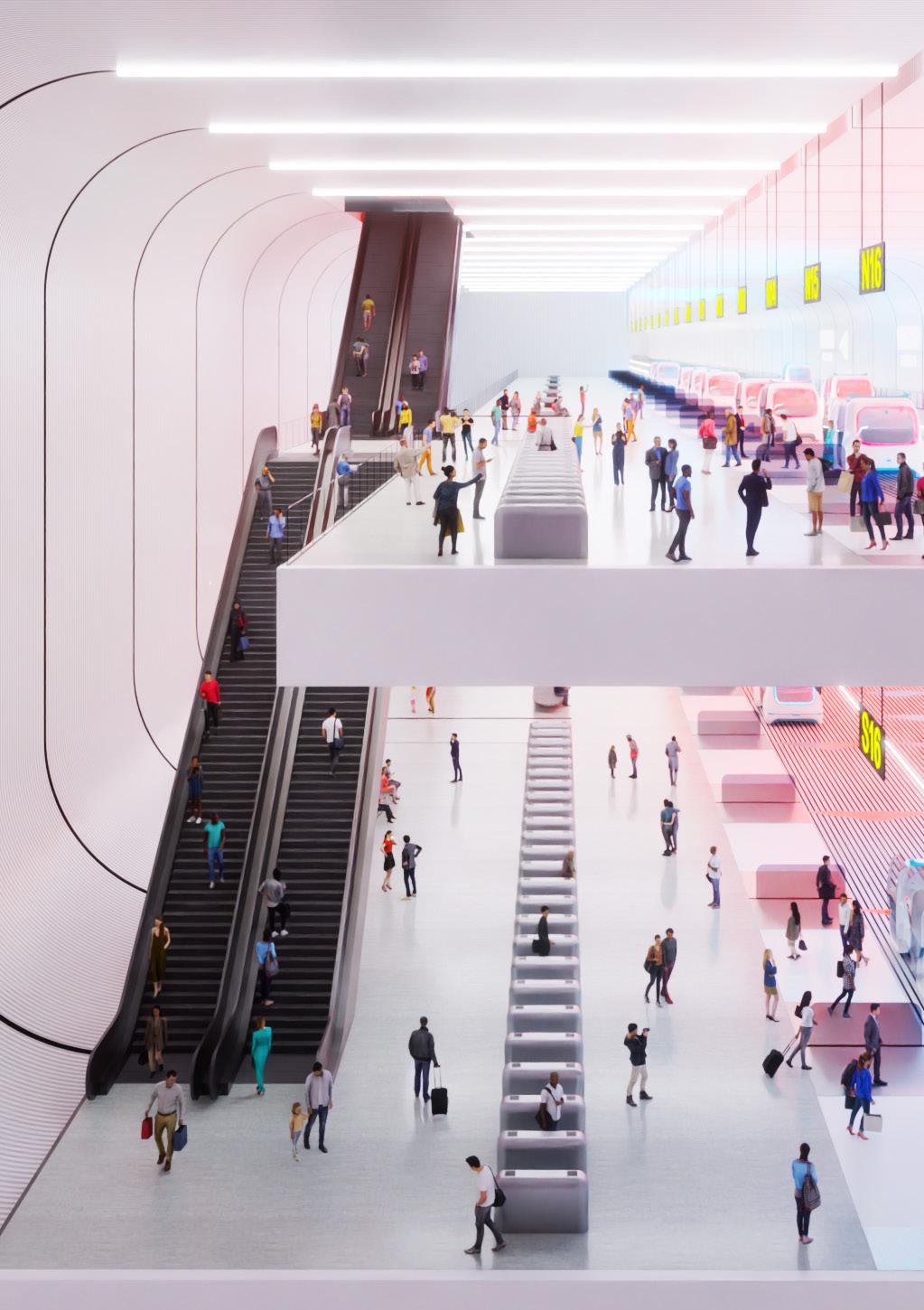
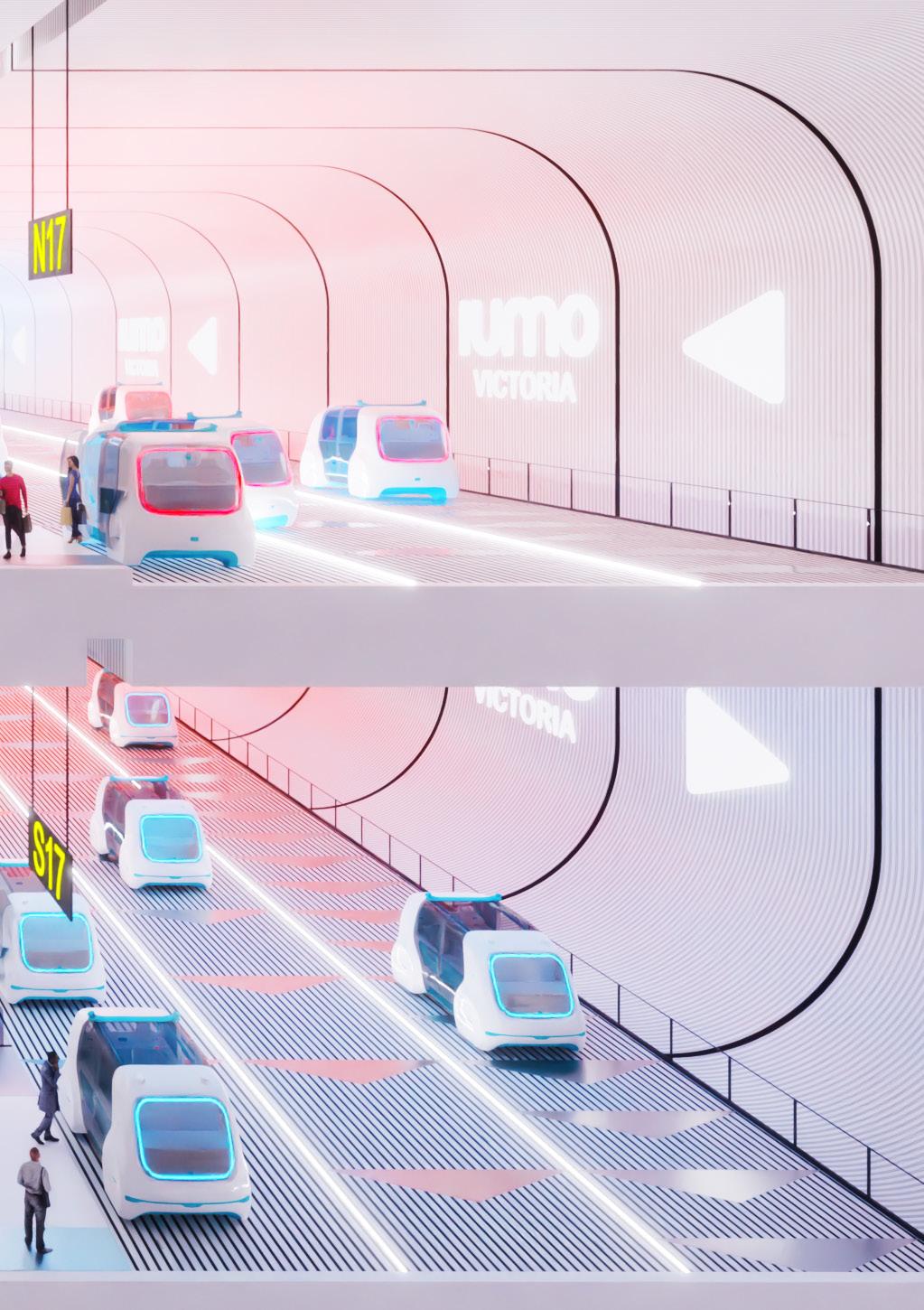
IUMO & Crossrail 2 key points 3
17
IUMO convenience
IUMO operates on a dynamic basis and reacts in real-time to fluctuating periods of demand.
IUMO‘s booking system operation results in significantly lower wait times for passengers.
The system caters to individual needs while also providing mass transit. The AEV pods are summoned by a seamless and intuitive booking system, in which a user may pre-book their route. Similar to a ride-share and ride-hailing scheme, the system groups together passengers and directs them to the available AEVs based upon their shared destination. Next, the vehicles transport the user directly to their desired destination, without interruptions in between. This direct approach results in journeys taking half the time compared to those taken on Crossrail 2.
The transit system not only reacts in real time to requests, but also prepares for anticipated patterns in surges or decreases as tracked by the system. By predicting and preparing the next hour’s transit demands, IUMO adjusts accordingly while maintaining its rapid response rate. For example, the system will expect to increase its capacity twice a day to respond to rush hour commutes. In the case of lower demand periods, such as from midnight to 5 am on weeknights, the system will optimise vehicle use.
PLP Labs
By blending technology, electric vehicles, and transport hubs, IUMO provides the ultimate personalised experience. This approach champions direct, reliable, and convenient transportation for all.
IUMO provides a quicker and more dynamic all-round service compared to Crossrail 2 in which large groups of passengers accumulate while waiting for the trains to arrive, especially during lower demand periods that incite long stretches of time without trains. Unlike Crossrail 2, the IUMO system is designed to respond to fluctuating demand periods, without sacrificing AEV availability and quick response to passenger requests.
IUMO will be managed over daily, weekly, and monthly periods to account for maintenance and upgrade schedules. For instance, software updates to the system, in additional to AEV cleaning and maintenance, will occur regularly to retain a positive customer experience. This continual review will provide information on long-term management. The system and fleet size will be reviewed on an annual basis to assess fleet size increases or replacements. Similarly, because the system uses individual AEVs, new models of the vehicle may be introduced gradually over time and replace old models. Overall, the system is continually monitored to provide a personalised and up-todate service.
19 IUMO & Crossrail 2 key points
CROSSRAIL
IUMO
IUMO requires a single tunnel, rather than two tunnels for Crossrail 2.
As IUMO does not employ fixed length trains, stations are sized according to anticipated demand.
To deliver the same capacity as Crossrail’s fleet of 30 trains, IUMO requires 1,500 vehicles.
As the system is ondemand, the IUMO fleet operates much more efficiently.
INFRASTRUCTURE COST INFRASTRUCTURE COST £32.6 BILLION £18.4 BILLION
COST 30 TRAINS £430 MILLION
COST 1,500 VEHICLES £150 MILLION PLP Labs
FLEET
FLEET
Overall, IUMO is expected to cost 35 percent less than Crossrail 2.
IUMO fleet and infrastructure costs are expected to be nearly half of the cost of Crossrail 2.
21
IUMO & Crossrail 2 key points
IUMO affordability
CROSSRAIL
IUMO
IUMO has key energy advantages in terms of acceleration, braking, friction, and air resistance while carrying the same load.
IUMO has a significantly smaller carbon footprint, based upon the annual operational energy calculations.
ENERGY PER PASSENGER 97,177 TONNES CO2e CARBON USE PER YEAR 1.5 KWH ENERGY PER PASSENGER 5,262 TONNES CO2e CARBON USE PER YEAR 0.3 KWH
PLP Labs
IUMO sustainability
IUMO will be three times more efficient than trains at rush hour.
IUMO only uses 20 percent of the energy of a train carrying the same load.
IUMO saves 91,915 tonnes of CO2 per year, compared to Crossrail 2.
IUMO is far more energy efficient than Crossrail 2 trains considering the comparison between the amount of energy required for acceleration and braking, as well as friction and air resistance of the two systems.
The energy comparison also reveals the fundamental difference between a fixed train system versus a flexible on-demand system. The acceleration costs of trains are high, since trains stop at every station; however many people board or disembark. IUMO being an on-demand system with small vehicles is far more energy efficient. These acceleration events completely dominate the energy use, other factors such friction and air resistance contribute very small amounts.
23
IUMO & Crossrail 2 key points
These calculations are based upon rush hour train and AEV capacity. It is likely that during times of lower demand, IUMO will be even more energy efficient considering its responsive nature, as underutilised vehicles will not be using up energy.
In total, it is estimated that IUMO is three-and-a-half times as efficient as the train solution and uses only 20 percent of the energy used by a train system carrying the same load. The different topology made possible by smaller on-demand vehicles makes a huge difference to the energy consumption — and hence carbon footprint.
91,915 tonnes CO2 saved per year
IUMO Crossrail 2 Total tonnes carbon per hour for full fleet (tonnes CO2) 0.6 11.1 Total tonnes carbon per year for full fleet (tonnes CO2) 5262.3 97177.3
PLP Labs
Comparison of energy use per hour for a full fleet for each vehicle type
of energy use per hour for full fleet for each vehicle type
25 IUMO & Crossrail 2 key points
Energy (kWh) IUMO CR2 0.00 0.20 0.40 0.60 0.80 1.0 1.20 1.40 Total acceleration energy per hour per passenger (kWh) Friction per hour per passenger (kWh) Braking energy per hour per passenger (kWh) Air resistance per hour per passenger (kWh)
Comparison
Energy (kWh) Total acceleration energy per hour for full fleet (kWh) Total breaking energy minus recapture per hour for full fleet (kWh) Friction per hour for full fleet (kWh) Air resistance at constant velocity per hour for full fleet (kWh) 997 799 9.6 24.5 30730 21511 2.9 1.7 0 5000 10000 15000 20000 25000 30000 35000 IUMO CR2
30 TRAINS
9,750 Tons
TOTAL WEIGHT
1,500 IUMO
2,250 Tons
TOTAL WEIGHT
The IUMO mass for all vehicles is 2,250 tons. Once multiplied by the number of stops, approximately 45,000 tons is expected to be accelerated. This is much lower than the overall train mass, which is 9,750 tons. Once multiplied by the number of stops in one hour, 204,750 tons of train mass is expected to be accelerated .
PLP Labs
Mass comparison
A fleet of IUMO vehicles weighs only 23 percent of a fleet of Crossrail 2 trains, this translates to greater speed and energy efficiency.
IUMO’s AEVs are charged on a more frequent basis and therefore could operate with fewer batteries than the standard electric car. Without the extra batteries, and by extension extra weight, the vehicles are light and easily able to accelerate at greater speed and efficiency. Please see annex for more in-depth information on mass and deadweight calculations.
The overall energy efficiency is also verified by comparing the mass accelerated by each system.
IUMO is up to four-and-a-half times as efficient as trains.
27 IUMO & Crossrail 2 key points
How the IUMO works
IUMO’s capacity is flexible and minimizes underutilised vehicles.
Platform sizes are tailored to demand
rather than the size of a train – thereby conserving resources and materials.
29 IUMO & Crossrail 2 key points
CROSSRAIL
IUMO
As IUMO is an ondemand system, vehicles wait for passengers as they enter the station, rather than the other way around.
IUMO’s average travel times, calcuted from the end station to a central station, are incredibly quick.
0 SECONDS WAIT TIME 3 MINUTES WAIT TIME 20 MINUTES TOTAL JOURNEY TIME 11 MINUTES TOTAL JOURNEY TIME PLP Labs
IUMO speed
IUMO is twice at quick as Crossrail 2 in transporting passengers to their destination.
IUMO passengers arrive at their destination faster than those travelling by train because they only stop at their destination.
IUMO journeys are far shorter than those of a traditional train system. A IUMO journey’s speed is due to a combination of the turn-around system, AI optimisation, and the on-demand nature in which AEVs only stop at their destination.
The system is built for AEV reversals at every station, which in turn permit vehicles to arrive and route to each point in the network more readily than Crossrail 2 trains. The topology of the IUMO network, including ramps, lifts, and two-way tunnel space establishes the foundation for quick travel for which AI can optimise.
Because IUMO is set up via a booking system, most passengers will experience no wait time between the time they arrive at the station and when they are directed to their AEV. In comparison, Crossrail 2 is expected to have a wait time at approximately three minutes.
31
IUMO & Crossrail 2 key points
System capacity
IUMO’s capacity is flexible because of the design of the AEV pods and because station platforms reflect real-time use. This responsiveness permits IUMO to operate on a personal scale while also meeting the needs of a large user base. In comparison, Crossrail 2 is a uniform service whose infrastructure does not readily adapt to changing conditions.
For instance, Crossrail 2’s one-size-fits-all approach is dependent on upon large crowds of passengers to wait for the same train on a set path. Therefore, trains maybe easily overcrowded, especially during rush hour. On the other hand, during off peak hours trains may be sparsely populated since trains always provide the same amount of space, without regard for the current demand. This is in direct opposition to IUMO’s model, in which smaller groups of passengers are immediately directed to available and smaller-scale AEVs that respond to both current and anticipated demand.
Not only is the system more apt at responding to passenger use, IUMO can readily exceed the passenger capacity of Crossrail 2 based upon peak train and station capacity.
PLP Labs
Fleet capacity
IUMO’s fleet size is only 20 percent of the vehicle capacity of Crossrail 2.
Because IUMO vehicles travel faster to their destination, this in turn also reduces the number of vehicles needed.
Because IUMO pods can reverse direction at all stations and reach destinations more quickly than Crossrail 2 trains, AEVs may cycle through the system at a faster rate than trains. Therefore, more ground is covered by fewer vehicles throughout the entire system. The IUMO operation optimises the vehicle system by minimising the number of underutilised AEVs. In comparison, Crossrail 2 trains are more inflexible and have an average occupancy rate of 30 percent. Therefore, more trains are needed to cover the demand in both directions.
33
IUMO & Crossrail 2 key points
Crossrail 2 train occupancy
Crossrail 2
Average 30%
New Southgate
Euston St. Pancras
Tottenham Court Road
Victoria
Wimbledon
Shepperton Distance
Crossrail 2 train occupancy is highest upon arriving at the three central stations. The darker shade represents occupancy load throughout the system.
PLP Labs
Occupancy Max Max Min Trains Trains
IUMO AEV occupancy
Shepperton
Because AEVs may reverse directions at every station, hence the occupancy rate is higher and the travel distance is shorter for each AEV compared to Crossrail 2. The darker shade illustrate the consistency of IUMO’s occupancy load throughout the system.
35 IUMO & Crossrail 2 key points
IUMO Average Travel 15km
New Southgate Euston St. Pancras Tottenham Court Road Victoria Wimbledon
Distance
Occupancy Max Max Min AEVs AEVs
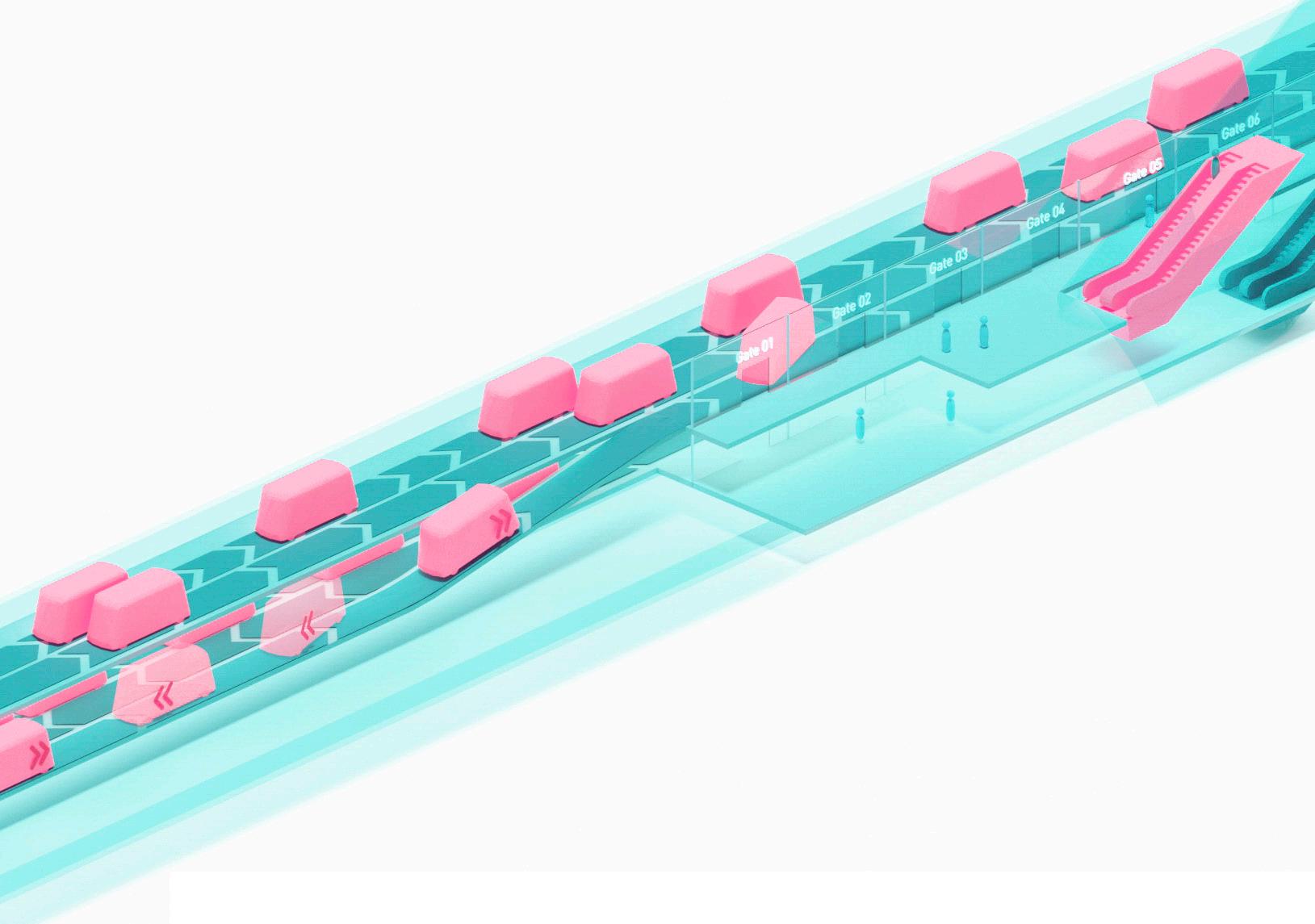
PLP Labs
IUMO AEV ramp model
Turn-around system
IUMO’s turn-around system has greater directional capabilities compared to traditional train systems. IUMO’s AI will generate a wide range of optimisation opportunities for each journey. By disrupting the limited, linear, and segmented method of traditional train service, IUMO optimises travel routes for all types of passengers.
The mechanics of IUMO’s turn-around system will be swift and coordinated throughout the system to ensure it responds appropriately and safely to users’ needs. First, IUMO’s turnaround system will be in the form of a ramp (or lift) at each station: eight in the northern section and seven in the southern section.
To achieve this feat, IUMO will utilise a form of platooning in which vehicles will be synchronised together at each turnaround to ensure a seamless journey.

37
IUMO & Crossrail 2 key points
IUMO AEV lift model
Routes
The Crossrail 2 train system has four turnround options, located at the end of each line and at Euston St. Pancras and Victoria stations. Within this schema, Crossrail 2 provides four total possible routes. By contrast, in the IUMO system offers a turnaround at every station for maximum flexibility. This amounts to 70 route options, in total, for vehicle optimisation.
During the morning rush hour, the vast majority of arrivals will be arriving at the three central stations – Euston St. Pancras, Tottenham Court Road, and Victoria.
During peak commuting hours, IUMO operates with the greater capacity than Crossrail trains at these three stations. A total of 42 AEVs will arrive per minute (2,530 per hour) at each station, transporting a higher amount of passengers as the expected 30 trains that run per hour.
IUMO’s platform length will match demand, and in some instances, are likley to be shorter than the standard 240 metre long platforms of Crossrail 2. Overall, IUMO’s stations are designed around expected passenger capacity per minute, unlike Crossrail, which is engineered around the length of the train.
Even accounting for a load time of one minute per vehicle, IUMO still outpaces the capacity of Crossrail 2.
PLP Labs
Crossrail 2 enables an additional 7 trains per hour (tph) on the South Western Main Line
Shepperton
Broxbourne
New Southgate
Dalston
Euston St. Pancras
Tottenham Court Road
Victoria
Wimbledon
Kingston 4tph
Hampton Court
Chessington South
Epsom
Tottenham Hale
Stratford
Liverpool Street
Waterloo
39
4tph 4tph
South Western Main Line train paths
South Western Main Line train paths 6tph 6tph 20tph 30tph 15tph 15tph 12tph IUMO & Crossrail 2 key points
Crossrail 2 Additional
Additional
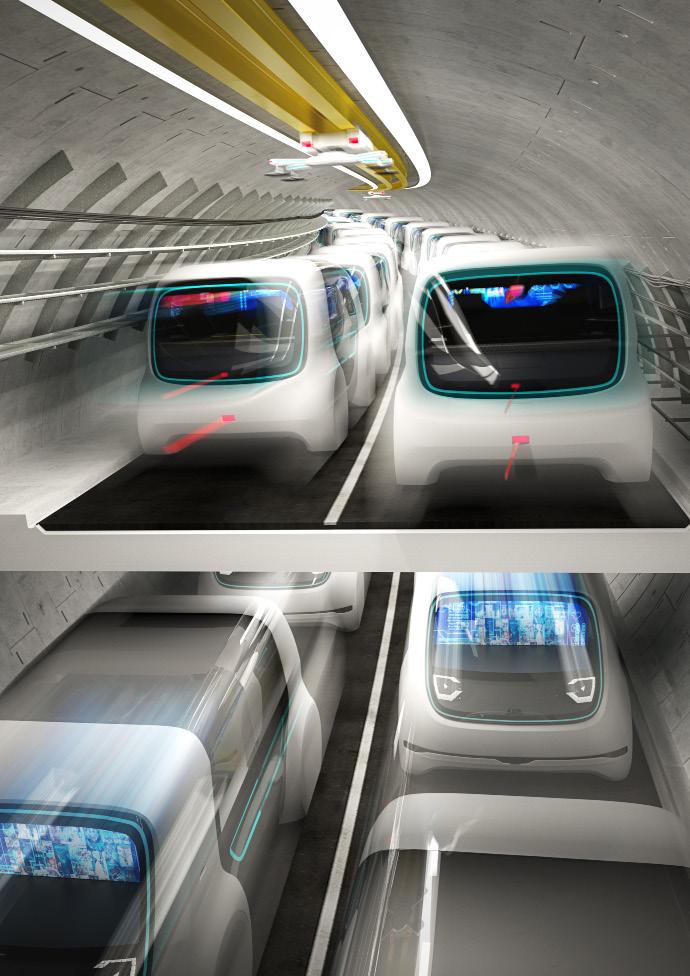
Conveyor belt spacing
One AEV will arrive every 2 seconds; a total of 125 IUMO vehicles will arrive to the three main stations every minute.
IUMO replaces conventional trains with digital platoons of shared AEVs running in a single Crossrail tunnel. Running at full capacity, pods will be kept at a fixed, uniform spacing of ten metres apart while traveling at a consistent and reliable speed.
When running below full capacity, the IUMO system can account for up to 20 metres in between each AEV. The AI system will maintain a fixed distance at all times so that vehicles are spread across the track to avoid any potential blockage.
Beyond the minimum standard spacing between vehicles, bottlenecking is unlikely to occur because there will often be more than one empty slot between moving vehicles. This movement is controlled via a dynamic platoon system, which permits AEVs to move within milliseconds of one another while traveling in a continuous flow at a steady speed without ever slowing down. This is also the case in both turn-around scenarios, in which vehicles will move together to ensure the network is seamlessly coordinated.
The IUMO system is effective because of this spacing of vehicles, which enables optimised occupancy of the tracks and a steady speed all while maintaining safety. The AI system works cohesively because of the mandated standard traveling speed and identification of empty slots. Overall, IUMO’s fleet is superior in terms of consistent speed, vehicle capacity, and efficiency.
41
IUMO & Crossrail 2 key points
Crossrail 2 Speed
Train speed with & without 2 min stops
NewSouthgate
TottenhamCourtRoad EustonSt.PancrasKingsCross
Victoria Wimbledon
Crossrail 2 train travels faster without intermittent stopping. IUMO applies this principle by not stopping at every station to achieve greater speed.
Speed calculations: 22 m/s angle equals 1km -2 minutes 20 seconds
Speed: 13 stops (each stop 2 mins inc. acc/dec), 30km takes 40 minutes = 45km/h 28mph
Speed: No stops, 30km takes 16 minutes = 110km/h 68 mph
PLP Labs
Time (Minutes)
Distance 10
20 30 40 50 60 70 80 90
Train speed with stops
Train speed without stops
IUMO Spacing
Spacing between vehicles
As measured by passengers per minute (ppm).
The diagram above illustrate the constant flow of IUMO vehicles, due to conveyor belt spacing, steady speeds, and consistent AEV reuse.
43 IUMO & Crossrail 2 key points
IUMO capacity by spacing
1200 ppm 1100 ppm 900 ppm
ppm 750 ppm 700 ppm
ppm
ppm
ppm
ppm
ppm 0m 1m 2m 3m 4m 5m 6m 7m 8m 9m 10m 11m 12m 13m 14m 15m Capacity in person per minute (ppm) 1000 ppm Preferred AEV Spacing Full Capacity AEV Spacing
800
600
500
400
300
200
The IUMO experience 4
45
IUMO passenger experience
The passenger experience begins with the booking system. Unlike conventional urban mass transit, the IUMO service may be pre-booked through a smartphone app. Through the app, the passenger may book journeys or be prompted to book a journey based upon their travel patterns.
For instance, once a common pattern of travel has been detected by the AI operation, the system will inform passengers of nearby and available AEVs which are heading to their destination.
PLP Labs Later IUMO 13.13 13.21 Later IUMO 13.13 13.21 Live tracker Live tracker Arrives first 13.10 13.18 BOOK BOOK To Victoria BUY BUY BUY From Dalston Date Fri 22 June Travelling Today, Now From Single Return To Arrival Time 13.20 Live tracker
The
IUMO control room
IUMO is controlled via a single point of operation — a hub which, through AI, regulates and coordinates the flow of the entire automated vehicle fleet.
The small vehicle size coupled with the magnitude of the fleet allows the system to be responsive and flexible. Artificial intelligence is a key aspect of this monitoring and control strategy to ensure a flexible, personalised, yet extensive system.
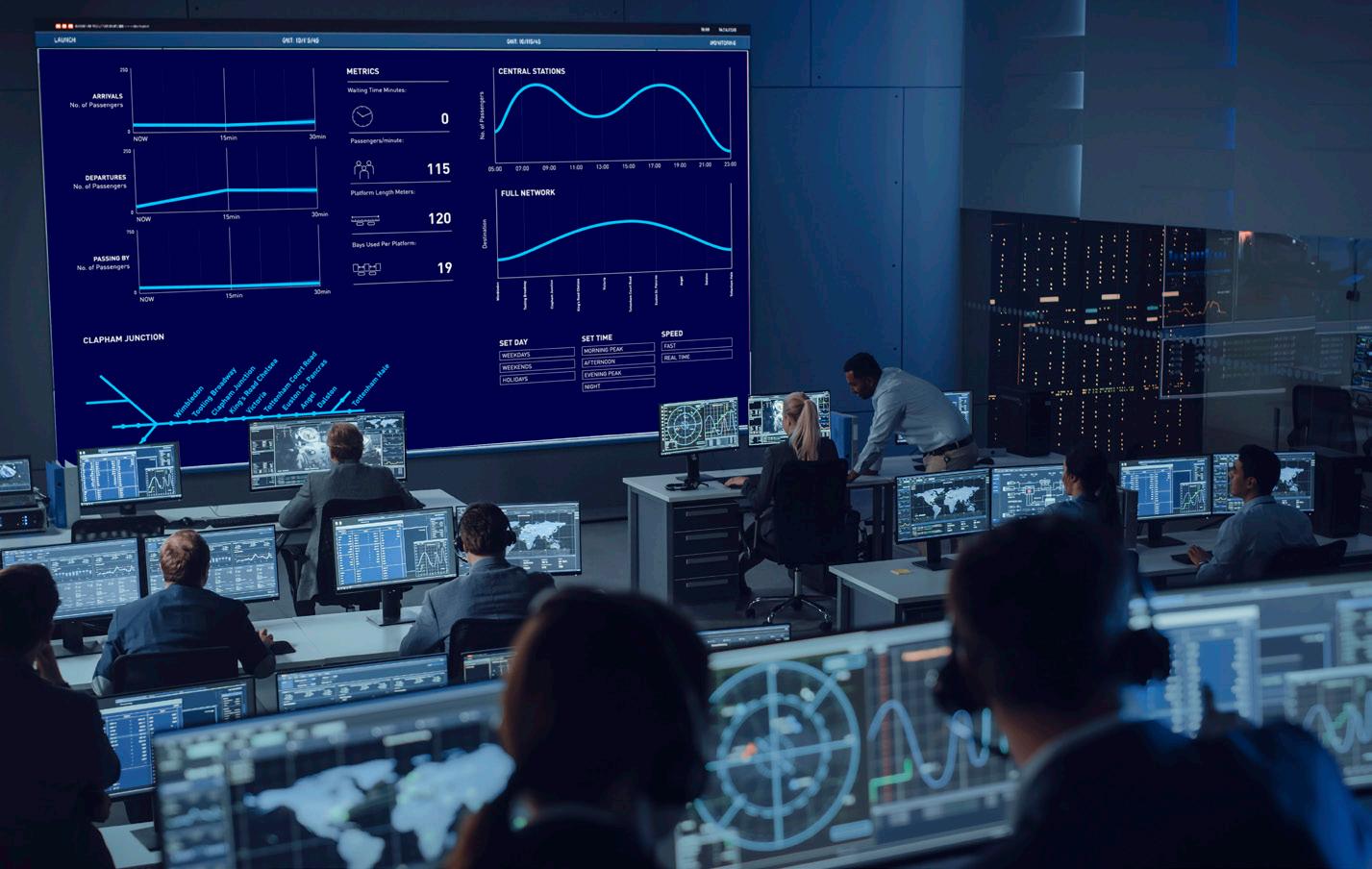
47
IUMO experience
IUMO operating system
IUMO is controlled by an operation system which monitors passenger and vehicle flows. The operating system is designed to maximise vehicle efficiency and passenger satisfaction.
First, the operation system maximises vehicle efficiency by monitoring and balancing the ratio between energy consumption and system capacity. For example, empty vehicle journeys will be minimised. The system will ensure optimal efficiency by responding in real time to these fluctuating changes.
Second, the operation system maximises passenger satisfaction in terms of wait times and best possible price. These two factors are linked by dynamic pricing which reflects the current demand in the system.
Measured in terms of passenger per minute (ppm) the graph illustrates the demand over the course of a day.
PLP Labs ppm 5am 6am 7am 8am 9am 10am 11pm 10pm 9pm 8pm 7pm 6pm 5pm 4pm 3pm At peak time full load is easy to achieve 2pm 1pm 12am 11am ppm ppm ppm ppm ppm ppm
Comparison of vehicle system efficiency and passenger satisfaction
Dynamic pricing
The IUMO AI forecasts demand based on data collection and pattern identification. These include patterns based on the day of the week, weather forecast, as well as any news signalling a change in demand such as a special event or sports game.
With this information integrated into the system, vehicles will be pre-positioned to meet expected demand. Throughout the day, the AI will monitor the system continuously and reprogram vehicle movements as needed. The system adapts to both anticipated and real time fluctuations in passenger numbers, energy, and routes.
IUMO relies on a dynamic pricing system in which prices will change depending on the demand and availability of AEVs. Passengers who commute during high periods of demand will have the option to wait for later vehicles at a discounted rate.
IUMO: I have reserved a seat in Bay 7 for you to get to Euston in 5 minutes. You are 1 minute away.
IUMO: But if you travel 4 minutes later, I can offer you a reduction in price of £1.50. Do you want to take the offer?
Passenger: Yes
IUMO: I have reserved a seat in 5 minutes in Bay 12. Please wait and let others pass you.
49
The IUMO experience
Passenger safety and security
To ensure passenger safety and security, the IUMO system will be monitored by CCTV with cameras posted in stations and inside of vehicles.
Alongside observing and monitoring the interior of 1,500 vehicles in real time, the AI system will also detect and report any suspect behaviour. For instance, the system will report if any passengers are standing up and moving about while the vehicle is in motion.
Beyond the security within vehicles and the detection system, passengers may personally submit requests for their AEVs. For instance, passengers may request a woman only, LGBTQIA+ friendly, or wheelchair accessible vehicle. Other categories may be gradually developed over time and incorporated into the system. Similarly, AEVs may be reserved for groups such as a family and/or a group of friends.
Beyond specific types of AEV groupings, the IUMO system may also provide a private booking option in which a vehicle is reserved for one or two passengers on an exclusive basis. In this case, dynamic pricing would also be implemented to ensure efficiency within the system.
PLP Labs
Vehicle safety and security
In the case of an emergency, a manual evacuation will be initiated in which vehicles will move to the second lane and passengers may be evacuated. This procedure will allow passengers to exit and walk to the nearest connector to the evacuation or maintenance route.
Stations will be designed to withstand a range of wide-scale emergency situations and accommodate mass evacuations. The IUMO system will adapt to current and future protocols for unexpected disruptions or perilous situations.
Aside from wide-scale emergency situations, the conveyor belt system will accommodate for small-scale disruptions. IUMO runs smoothly and efficiently when the fast lane maintains its designed speed. When any deviation from the fixed speed occurs, the AEV will move to the secondary lane and continue to the nearest station. If the vehicle is unable to move, another IUMO vehicle will push it to the nearest station or maintenance base.
For more detailed information on the IUMO study, an Annexe is available upon request.
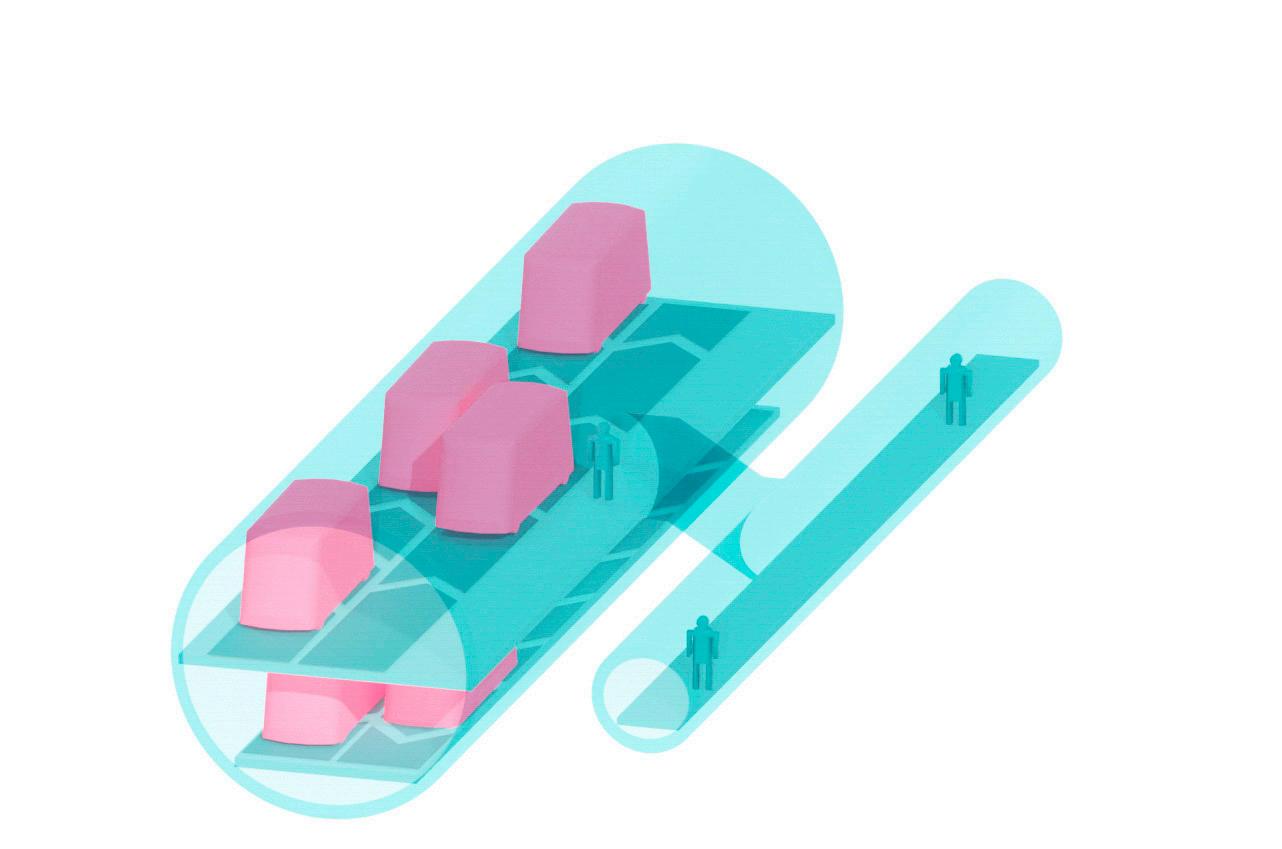
51
The IUMO experience
Looking forward 5
53
The IUMO future
IUMO has the potential to be the transport network of the future. The system offers clear advantages in terms of convenience, economic viability, and sustainability. IUMO is far better equipped to serve London’s transport needs by integrating cutting-edge technology within the time-tested underground infrastructure.
Looking toward the future, the system reflects the present and upcoming transportation trends. IUMO has the potential to serve all different kinds of passengers and travel patterns. Unlike models of the past that predominantly focused on the daily commute and a straightforward path of travel, IUMO offers convenience to those on multi-stop trips across the city. Whether an individual, group, or family is commuting to the workplace, running errands, sightseeing, or going out on the town — IUMO offers the same, convenient and on-demand service 24/7.
IUMO offers both cutting-edge advancements and a system that mirrors the future of transport patterns that can set the new standard for mass public transport across the world. The model is simplistic enough to implement, especially within existing underground infrastructure, and yet offers a radically enhanced transport model.
Ultimately, IUMO champions the core priorities of today’s modern world — convenience, affordability, and sustainability — thereby moving the world closer to a better future for passengers and the planet.
55
Looking forward
57
Shibuya-ku Tokyo
PLP Architecture Ibex House 42-47 Minories London EC3N 1DY UK T +44 (0)20 3006 3900 www.plplabs.com www.plparchitecture.com Shoto Mansion 703 Tomigaya 2-19-8
151-0063 Japan T +81 (0)90 9831 1853







